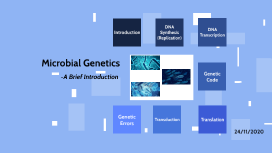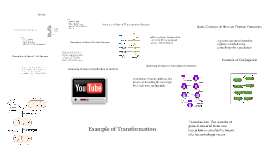Microbial Genetics
Transcript: People will develop more diseases as bacterias can mutate and be even more dangerous since there are no vaccines for it. And creating a vaccine for one person can take a months nor years if it succeeds. If creating a vaccine for one person is taking a long time how would it be if you are producing vaccines for billions of people. However, there are some bacterias that can help Importance Mutation (mutation) technology, gene recombination technology, gene replacement, amplification technology A series of genetic modification techniques such as Atractylodes macrocephala, transfer, recombination and modification of extrachromosomal genetic materials, and the structure and properties of some biological genetic materials (chromosomal DNA, RNA, plasmid DNA) Reasons: Found and confirmation : Screening and constructing transforming and degrading microorganisms, improving genetic stability of Engineering bacteria, providing more scientific, rapid, accurate and diverse environmental monitoring and assessment techniques, and helping to synthesize biococoa Screening and construction of transformed microorganisms Industry and Environment Microbial genetics will be helpful to increase these(antibiotics or medicine related to microbes) products productivity by microbial technology. This means that the health industry are earning heaps of money because of the fact that people are needing so much treatment and researches to be able to cure. Citations Microbial genetics is a branch of genetics that studies viruses, bacteria, small fungi, single-celled animals and plants.Microorganisms are good materials for genetic research because of their small size, short life cycle, rapid propagation on simple synthetic media, and the ability to process large numbers of individuals under the same conditions One is to use the traditional mutation breeding and cross breeding technology to screen and cultivate highly effective strains of microorganisms.The strains have been used in the treatment of printing and dyeing wastewater, pesticide production wastewater and tailings wastewater, as well as in the removal of petroleum pollution and garbage degradation. Microbial Genetics Provide more scientific, fast, accurate and diverse environmental monitoring and environmental protection. Environmental assessment techniques In this field, biodegradable materials synthesized by microorganisms have attracted wide attention and have broad application prospects. For example, microbial fermentation is the main way to obtain biodegradable plastics at present. The materials needed for production in such techniques are obtained from the fermentation process of a particular microorganism, which is the fermentation product of a microorganism and a specific substrate. Relevant microbial genetic techniques help to screen, cultivate, domesticate and recombine engineered fermentation bacteria in such technologies, thereby introducing new metabolic pathways, synthesizing novel polymers, broadening the use of substrates, increasing production speed and reducing production costs. Selecting and construction the degradation and transformation.Microorganisms are good materials for genetic research because of their small size, short life cycle, rapid propagation on simple synthetic media, and the ability to process large numbers of individuals under the same conditions Health/Care and Diseases "Microbial Genetics." The Gale Encyclopedia of Science. Encyclopedia.com. 27 Aug.2018 <http://www.encyclopedia.com> Holmes, Randall K., and Michael G Jobling. “Medical Microbiology.” Ncbi.nlm.nih.gov, University of Texas Medical Branch at Galveston, 1996. Mori, Hirotada. “Microbial Genetics, Genomics, and Proteomics.” Bmcmicrobiol.biomedcentral.com, BMC Microbiology, 2018. And because of the mutations of some bacterias, people are being detained in a hospital or they may be unfortunately dead because of lack of treatment (such as vaccine, if its rare) and time (ran out of time to research, create, and produce a vaccine). How is gonna effect: By: Ashyley Xu & Mercy Yagao Genetic code, transcription, translation,messenger ribonucleic acid (mRNA), transfer ribonucleic acid (tRNA) and so on are found or confirmed in microorganisms. Helping to synthesize biodegradable new materials Importance Another way is to use genetic engineering technology to construct efficient transformation and degradation engineering bacteria. Microbial genetics promotes the development of production. The principle of improving the final product by eliminating repression has been applied to the fermentation of amino acids and nucleotides with remarkable yield increase. The application of recombinant DNA technology in industry, agriculture and medicine is more difficult to estimate, and recombinant DNA technology is also the product of microbial genetics research. Microbial genetics research has also made an important contribution to medical and health services, especially in the detection of carcinogenic

















